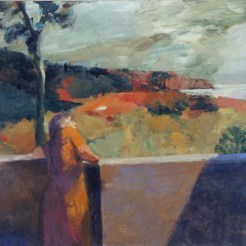Elmer Bischoff
The Late Abstractions
June 23 – July 30, 2005
John Berggruen Gallery is pleased to present an exhibition of abstract paintings from the 1970's and 1980's by Elmer Bischoff. This exhibition opens June 23rd and will run through July 30th.
Born in 1916, Elmer Bischoff earned both his BA and MA at UC Berkeley. He went on to become a Professor at Berkeley, teaching from 1965 -1985. By the time he died in 1991, Bischoff had established himself as one of the most important California artists of the 20th Century. An integral part of the Bay Area Figurative School, Bischoff worked along side Richard Diebenkorn and David Park, while also defining and refining his own stylistic approach. Elmer Bischoff began his long career as an Abstract Expressionist painter in the late 1940's. Yet in the early 1950's, he turned away from abstraction and began exploring representation. For the next 20 years, his primary subject matter was landscape and the human figure. Bischoff made a sudden departure from figuration in the late 1970's and reverted back again to abstraction.
This exhibition features a selection of these late abstract paintings from the 1970's and 1980's. The paintings from Elmer Bischoff's late abstraction period are characterized by the dualities of formal elements that exist in both harmony and opposition within his paintings. In other words, Bischoff employs both hard and soft edges, large and small forms, thick and thin lines, opaque patches and transparent washes, slow and quick marks, symmetry and asymmetry. There is a mingling of both an architectural geometry and an organic lyricism in all of the works. Each painting is endowed with a rich rainbow of color, colliding shapes, and a general sense of spontaneous movement and raw energy.
Elmer Bischoff received an Honorary Doctor of Fine arts Degree from both CCAC in 1989 and from The San Francisco Art Institute in 1985. In 1988, he was named a member of the American Academy and Institute of Arts and Letters. Elmer Bischoff's work can be found in a number of important public and private collections, including the Art Institute of Chicago, The Museum of Modern Art in New York, The Whitney Museum of American art, The San Francisco Museum of Modern Art, and the Oakland Museum.










